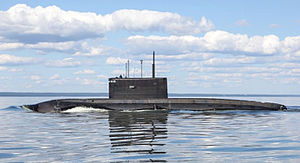
Back غواصة كيلو Arabic Projekt 877 Czech Kilo-klassen Danish Projekt 877 German Clase Kilo Spanish Kilo-klassi allveelaevad Estonian زیردریایی کلاس کیلو Persian Classe Kilo French קילו (סדרת צוללות) HE Podmornice klase Kilo Croatian
 Russian Black Sea Fleet Improved Kilo–class submarine B-265 Krasnodar in 2015
| |
| Class overview | |
|---|---|
| Builders | |
| Operators | See Operators |
| Preceded by | Tango class |
| Succeeded by | Lada class |
| Subclasses | Sindhughosh class |
| Built | 1980–present |
| In service | 1980–present |
| In commission | December 1980–present |
| Building | 2 |
| Completed | 83 |
| Active | 65 |
| Lost | 1 |
| Retired | 16 |
| Preserved | 1 |
| General characteristics | |
| Type | Attack submarine |
| Displacement |
|
| Length | 70.0–73.8 m (229 ft 8 in – 242 ft 2 in) |
| Beam | 9.9 m (32 ft 6 in) |
| Draft | 6.2 m (20 ft 4 in) |
| Installed power | Diesel-electric |
| Propulsion |
|
| Speed |
|
| Range |
|
| Endurance | 45 days |
| Test depth |
|
| Complement | 52 |
| Armament |
|


The Kilo-class submarines are a group of diesel-electric attack submarines designed by the Rubin Design Bureau[1][2][3] in the Soviet Union in the 1970s and built originally for the Soviet Navy.
The first version had the Soviet designation Project 877 Paltus (Russian: Па́лтус, meaning "halibut"), NATO reporting name Kilo. They entered operational service in 1980 and continued being built until the mid-1990s, when production switched to the more advanced Project 636 Varshavyanka (Russian: Варшавянка, after the revolutionary song of the same title) variant, also known in the West as the Improved Kilo class.[citation needed] The design was updated again by the Russian Navy in the mid-2010s, to a variant called Project 636.3, also known as Improved Kilo II.
- ^ a b Gady, Franz-Stefan (7 October 2019). "New Russian Attack Sub Enters Sea Trials". The Diplomat.
- ^ a b "АПЛ Проекта 636.3" [Project 636.3 Nuclear Submarine]. pp.userapi.com (in Russian). Archived from the original on 30 August 2017. Retrieved 30 August 2017.
- ^ Cite error: The named reference
diplomat20191122was invoked but never defined (see the help page).
© MMXXIII Rich X Search. We shall prevail. All rights reserved. Rich X Search